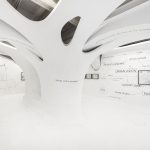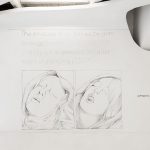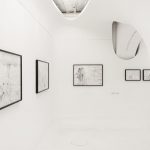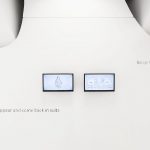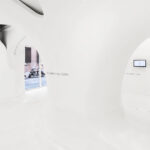studio ASYNCHROME
Urban Vision 2.0
Ex Elettrofonica, Rome. 8 June-7 September 2018
Urban Vision 2.0 was the first Italian solo show of the Austrian duo studio ASYNCHROME (Marleen Leitner and Michael Schitnig), hosted by Ex Elettrofonica gallery and curated by Manuela Pacella.

studio ASYNCHROME’s artistic practice lies in a liminal space between architecture, art and urban research, through the creation of drawings on paper and walls dealing with certain key concepts, like Utopia. The artists begin from the idea that utopia has to be understood neither as a failed plan nor as a building task. It rather serves as tool and method to work critically and artistically not doomed to failure, but as a way to change the world.
The very idea of placing the Austrian duo’s work in an architecturally complex space like Ex Elettrofonica means working on various levels, where art and architecture are forced to dialogue. Rome is then added to this mix, seen through the eyes of a foreign visitor/researcher, already shaped by prejudices, common places and romanticisms.
studio ASYNCHROME developed the final project, called Urban Vision 2.0, following a period of research in Rome in November 2017, when they visited the city (from its historical sites to its outskirts), and also communicated with representatives (artists, historians, curators) whom they asked questions leading to further queries like: What does urbanity, vision and above all 2.0 mean for Rome? How do local events connect with global / European trends? Which circuits contribute to (not) work? Could chaos be potential? Which levels should be combined in the drawn conversation of past, present and future?
The result is a dialogue between the various parameters (temporal, political, social) that distinguish Rome as a place where even paradox is constantly changing its connotations. A city/chaos where sometimes it seems that only intuition, and a certain kind of attitude, can stimulate continuous possibility of success.
In a generic dystopian atmosphere of approach to the future, studio ASYNCHROME faces utopia with a veiled, uncertain, questioning, but always constructive, lens.
The title of the exhibition refers to the name of a famous company in the sector of sponsored restorations of buildings and monuments – Urban Vision – and is ironic about the concept of 2.0 and how Rome can be updated when the dialogue between the various players is in constant flux. In the gallery, this basic idea is made explicit by the interaction between the works on paper, on the wall and the animated drawings.
The exhibition was made possible by: Bunderskanzleramt Österreich; Das Land Steiermark. Wirtschaft, Europa und Kultur; Forum Austriaco di Cultura in Rome.
Thanks to: Maria Alicata, Lorenzo Benadusi, Claudia Cavalieri, Julian Jauk, Valerio Mannucci, Elena Papadia, Cesare Pietroiusti, Emanuela Pigliacelli.
studio ASYNCHROME is a multimedial and multi-disciplinary due founded in Graz in 2013 by the architects, designers, photographers and painters Marleen Leitner (1986) and Michael Schitnig (1986). The works of studio ASYNCHROME have been exhibited in various shows and institutions, including: at the Neue Galerie in Graz, the Vienna Biennale, <rotor> – the Centre for Contemporary Art in di Graz, the National Museum of Art, Architecture and Design in Oslo, Design Week in Beijing, the Kunsthaus Graz, the Steirischer Herbst festival, the House of Architecture in Graz, the ART Steiermark in Brussels, the Stadtpark Forum, the Grazmuseum, the OK – Offenes Kulturhaus in Linz and the Architekturzentrum in Vienna, in the Museumsquarter. In 2014, their comic-manifesto Niemandsräume/No mans spaces for TU-Graz press was released with the support of the Institute of Contemporary Art in Graz.
Rome as E-utopia
The entire city is accessible to everyone; and people go to where they are drawn.
There is no conflict, because people who have the same opinions always find each other. Bruno Taut, The City Crown, 1919
In 2014, Marleen Leitner and Michael Schitnig – known as studio ASYNCHROME – produced Der Weltbaumeister, an animated film inspired by Bruno Taut’s 1919 The World’s Master Builder. The boards used for the video were then reused for the beginning of the comic book Niemandsräume. Eine utopische Spurensuche – No Man’s Spaces. A Utopian Search for Traces, published for the TU-Graz press in collaboration with the IZK Institute for Contemporary Art, as the outcome of their thesis in architecture.
It is a true artistic manifesto, where studio ASYNCHROME, using text, drawings and the narrative structure of a comic strip, tackle the difficult theme of utopia in relation to architecture and urban planning. Taut’s expressionist utopia is a source of inspiration and basis of a reflection on the human-architecture relationship. While for Taut, architecture was a point of fusion of all the arts, for the Austrian duo, it instead becomes more and more disharmonic with the social body living in it.
Here begins a utopian discourse that again involves the double meaning of the original English word that Thomas More’s 1516 Utopia was based on, that is, e-utopia (homophony between utopia, which in Greek means “no place” with eutopia, meaning “good place”).
With a vision of utopia thus becoming a tool for critical analysis with a newly proactive meaning, studio ASYNCHROME chose to dedicate themselves to the visual arts rather than architecture, believing that visual art is freer and therefore more effectively active.
Curiosity led the artists to investigate the fabric of Rome, so full of historical layers, of religious, cultural and political pilgrimages, of beauty together with daily chaos and idleness. They asked questions and engaged in dialogue with various figures living and working in Rome; visiting the most touristy sites, the most precious corners, the meaningless suburbs, the magnificence of apparent grandeur, the constant architectural change in the succession and intertwining of suburban neighbourhoods with many political faces.
The result is Urban Vision 2.0, a hypothesis of analysis, a proposal of interconnection between the various aspects they found, at times paradoxical, at times almost ironic, where that “Urban Vision” is a direct reference to the name of a famous company for sponsored restoration of buildings and monuments.
The network of connections between concepts, sentences, drawings on the wall and on paper, is brought to life in a constant state of updates and change, thanks to the activation of the network by visitors. While the intermingling of facts, places and sentences extrapolated from life, news and media in the small diary-like drawings are of local relevance, their ‘urgency’ becomes clear when compared to more global themes, analysed in large-format works on paper, while the bitter irony of the two video animations and of the wall drawings are a visual counterbalance to the words on the walls, deliberately disrupting any attempt at linear narration.
The context in which Urban Vision 2.0 develops is the not exactly reassuring space of Ex Elettrofonica in Rome, famous – in its almost ten years of activity – as a place of architectural challenge for the artists called to work there.
And here, from the right angles they were used to, studio ASYNCHROME had to deal with organic architecture (to quote Bruno Zevi), where the central tree of the exhibition space could refer to the pre-architecture of the Der Weltbaumeister – The World’s Master Builder video, that is, to nature as the first form of shelter from the elements, a reflection of that (only apparent?) chaos which everyone complains about but which is in line with the spirit of adaptation, acceptance and resilience that Rome and its inhabitants have, not just as a survival instinct but as probably the only form of success, not at all utopian and very close to reality.
Manuela Pacella
